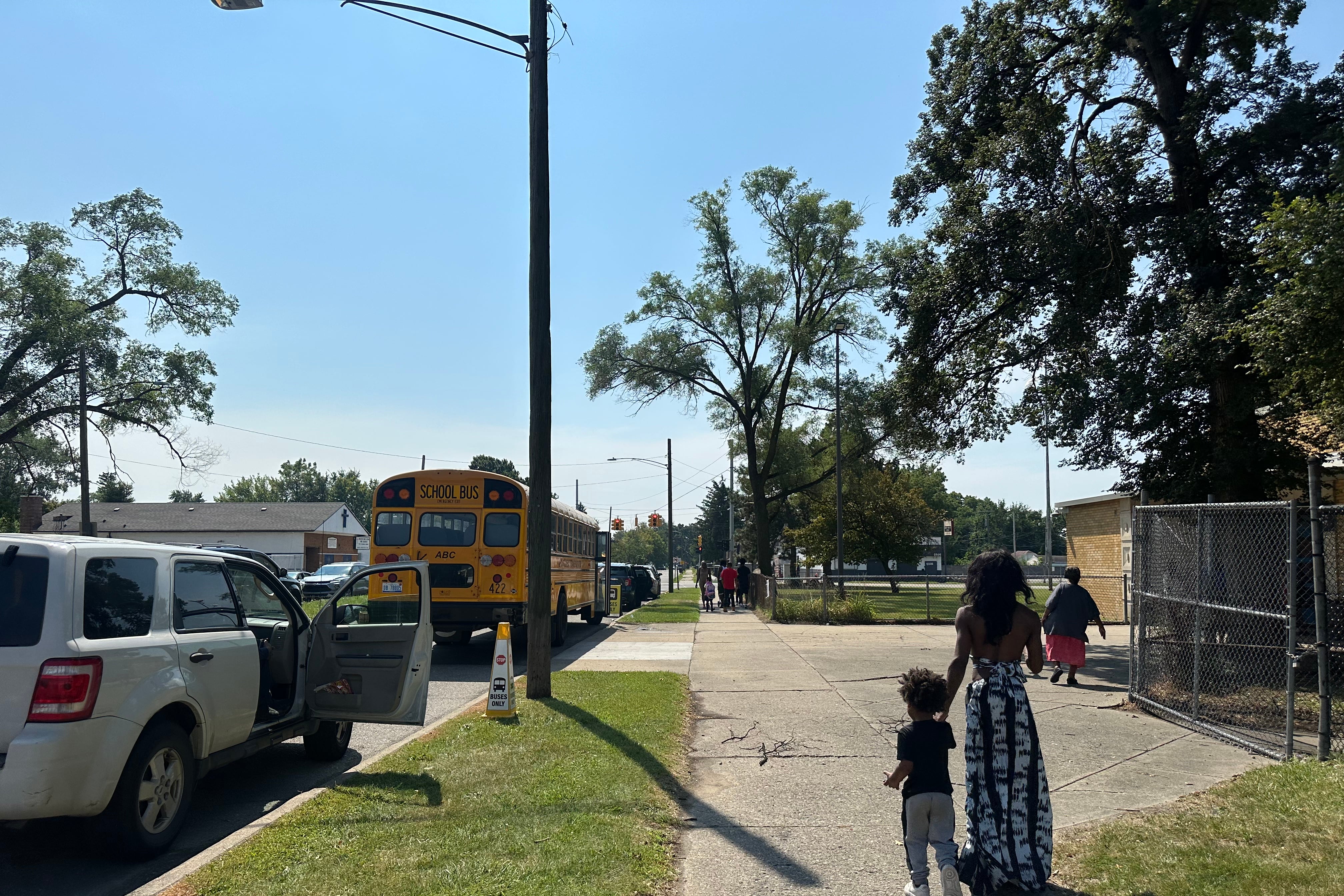This story was produced through a collaboration between BridgeDetroit and Climate Central. Kaitlyn Trudeau, Jennifer Brady, Arielle Tannenbaum, and Joseph Giguere of Climate Central contributed data reporting.
The Lyft Nena Kae had pinned her hopes on had just canceled on her, so as she stood on the blistering sidewalk in front of Barton Elementary School with her toddler and kindergartener, she weighed her options. None was good.
“I’m stranded, and I can’t get home,” she said. “I would have been able to work something out if it was 3 p.m.”
It wouldn’t be 3 p.m. for hours. The district released her kindergartner and 52,000 other children from school early because of the heat. The people she’d normally call for a ride weren’t available so early. It seemed they might have to walk home.
“I only live five minutes away, but it ain’t walking distance for them because it’s hot.”
Detroit Public Schools Community District has implemented a policy to cut school days short when the city’s heat index, a reference to combined heat and humidity, reaches 90 degrees. When a heat wave hit the city on the first two days of school this week, the district released all students three hours early.
As pollution has trapped more heat in the atmosphere, school days reaching this threshold have become 50% more common in Detroit than 45 years ago, an analysis of weather records found. These days are exacerbated by urban heat, produced by blacktop and concrete that trap heat and a shortage of trees for shade and other plants. In the coming 25 years, some projections suggest the frequency of these superhot days in the city could quadruple.
The problem is national. An analysis of 243 cities in the Lower 48 found that since 1970, cooling demand during the back-to-school period has increased in 231 of them. This is not a problem of mere comfort, experts say: Extreme heat hinders children’s health, development, behavior, and capacity to learn.
Places that have always coped with extreme heat during the school year tend to have air conditioning systems already in place, making them more resilient against heat-related learning loss. But for places that historically got by without cooling systems, the fix will be expensive and protracted.
Michigan is one of 21 states identified in a White House report that don’t conduct statewide facility assessments or require school districts to do so, meaning the number of schools lacking air conditioning is not known. The Center for Climate Integrity, a nonprofit focused on quantifying the costs of climate damages and holding the fossil fuel industry accountable for them, estimated in 2021 that adding or updating air conditioning at schools could cost more than $1 billion.
In Detroit, fewer than half of schools have air conditioning systems. During the next five years, DPSCD intends to increase the number of schools with air conditioning to 90%. Until then, hot days will continue to leave students waiting for rides in the heat and parents scrambling to pick their kids up during a workday — even for those whose schools are equipped with air conditioning.
“Five years, that’s a long time,” said Raven Davis, who was worried about how the early release days could affect her work at a clothing store. Davis was on her second child pickup of the day at Mackenzie Elementary after picking up her youngest from a school 15 minutes away.
Davis said the early release plan for high heat days was “crazy,” considering that Mackenzie Elementary has air conditioning.
“The schools that actually do have air conditioning, they should be able to do a full day,” Davis said.
DPSCD Superintendent Nikolai Vitti said an early release is better than canceling school altogether.
“When we start talking about over 90 degrees in schools with the heat index, it becomes a distraction to focus, teaching and learning,” Vitti said.
Vitti said existing transportation options would make it too difficult to offer different school schedules.
“We just feel like it’s best for the students and the staff to be having an early release … because at least we continue the regularity of attending.”
Here’s what is causing schools’ heat crisis
When most of Detroit’s schools were built, no one thought to install air conditioning because sweaty summer days typically ramped up after school let out and eased off before the first day back. Today, Detroit’s heat season is extending both earlier and later, said Richard Rood, a professor emeritus at the University of Michigan, whose research includes climatic shifts and adaptation in Detroit. “So we’re going to have to start thinking about heat more than we used to.”
That was certainly true this week: Monday was 8.1 degrees warmer than usual, and Tuesday was 9.6 degrees warmer. The latter sent the heat index above 100 degrees and prompted a heat advisory from the National Weather Service. Heat-trapping pollution in the atmosphere made the heatwave at least three times more likely to occur, according to an analysis using Climate Central’s Climate Shift Index.
Detroit’s developed landscapes contribute to the high temperatures. Modeling shows the block Barton Elementary School sits on, where Kae was stranded with her toddler and kindergartner, can be up to 8 degrees warmer than schools in rural neighborhoods just outside of the city. Research by Rood has shown that the cooling effects of winds blowing over Lake St. Clair can help temper these impacts.
Excess heat comes at a great cost to children. Children’s bodies heat up more quickly than adults, making them especially vulnerable to asthma attacks, fainting, organ failure, seizures, and in extreme cases, death. Research shows that kids who suffer through heat waves experience more anxiety and depression.
Heat also radically stymies kids’ ability to focus, learn new skills, and retain information.
“The high temperatures definitely impact our students’ learning ability,” said Lakia Wilson-Lumpkins, president of the Detroit Federation of Teachers. “We know that these buildings are well insulated so when the heat gets in, it’s trapped. Opening a window may occur if the windows are functioning. There are a few schools that have no windows in the classrooms.”
Wilson-Lumpkins said opening the windows can then lead to bees getting inside classrooms and squirrels climbing the bricks outside causing “a whole other level of distraction.”
“Kids are screaming because of bees … they begin to have nosebleeds. They throw up. It’s the same for staff,” Wilson-Lumpkins said. “We would much rather err on the side of caution than have to deal with some sort of injury or incident.”
Some kids find no relief even when they get home: 7% of Detroit’s population, including 15% of Black families, lack any kind of air conditioning at home, according to the U.S. Census Bureau and an analysis by the Brookings Institution, a nonpartisan think tank in Washington. This takes its own toll on learning, making it harder for students to do homework or sleep, said Lindsey Burghardt, chief science officer at the Center on the Developing Child at Harvard University.
“Learning doesn’t end when kids leave school,” Burghardt said. “So much of the processing and cementing of what they learn during the school day happens when they’re asleep.”
The learning Detroit students lost this week could show up in their test scores years from now, Burghardt said. A study published in an economics journal in 2020 compared 16 years of temperature records and test scores and found that high schoolers who had experienced an abnormal number of hot days in their schooling scored worse on the PSATs than kids from the same schools during cooler periods. The researchers concluded that a 1-degree hotter school year can cause about a 1% reduction in learning that year.
Because Black and Hispanic students are the least likely to have air conditioning in their schools and also in their homes, researchers deduced that extreme heat accounts for roughly 5% of the racial achievement gap.
But that also suggests a simple way to ameliorate some of these effects: through investing in cooling systems. If a classroom’s temperatures are lowered from 86 to 68 degrees, students’ classroom performance improves by 20%, according to a 2019 study by researchers in Denmark and Chile.
“Can you imagine if there was another school intervention that had that much impact?” Burghardt said. “We’d be all over it.”
Detroit district to invest millions to increase its air conditioning coverage
Zaire Brooks, a ninth grade student who just moved to Detroit from Alabama, where he attended schools that lacked air conditioning, said he was used to the heat but that it did affect him.
“The heat can get to you sometimes — it drains your energy,” Brooks said. Drinking water helps, he added. “If you just stay focused, that’s how I got through, I was just drinking a lot of water.”
The district plans to invest $125 million into expanding its air conditioning coverage to 90% of school buildings by 2030. The remaining 10% are older and modernizing their cooling systems will be more costly, said Vitti, the superintendent. He said those schools may eventually be closed completely.
“We have to look at whether they would be phased out or continued in the next five years,” he said.
It’s estimated that 36,000 public schools nationwide lack adequate HVAC systems, according to a 2024 White House report. Using funds from the 2021 American Rescue Plan Act, schools across the country are expected to receive nearly $10 billion toward modernizing their HVAC systems in the next few years, according to the report.
That’s far shy of the estimated $40 billion needed to install cooling systems in every American school that needs it, said Paul Chinowsky, a professor emeritus of engineering at the University of Colorado at Boulder who contributed to an analysis of the nation’s deficit of cooling systems in classrooms.
“If you draw a line from about Washington D.C. across the middle of the country, everything north of that line was not built with air conditioning in mind,” Chinowsky said.
Paying to cool classrooms would pay off, both for children’s welfare and economically, said Burghardt
“Anything we do to protect children in early childhood is going to have a really positive effect on all the outcomes we care about — learning, mental health, physical health,” she said. “But the converse is also true.”
In the meantime, Detroit’s teachers must fight back the heat as long as possible, says Wilson-Lumpkins.
“As the temperatures rise throughout the day, teachers reduce computer usage because they make the room warmer. They turn the lights out. There’s not much you can do when it comes to instruction once the temperatures get to that point,” she said.
At the air-conditioned Detroit Lion Academy, a group of students had been sitting outside Tuesday afternoon in 92 degrees for an hour since school had let out early.
“I’ve been sitting here since 12:20 p.m.,” said one seventh grader, who was struggling to get in contact with his cousin.
Another seventh grader, seeking relief under a tree, said it was cool that school was let out early, but he didn’t really understand why.
“That’s crazy they canceling school just ‘cause of the heat,” he said.
Wilson-Lumpkins of the Detroit Federation of Teachers said some parents have pushed back on the early dismissals, saying they were in the same buildings as kids and it was fine for them, so why is it any different now?
“It’s climate change,” she said.
Jena Brooker is a reporter for BridgeDetroit. You can reach her at jbrooker@bridgedetroit.com
Katie Worth is a freelance reporter based in Northern California. You can reach her at katieworth@gmail.com.






